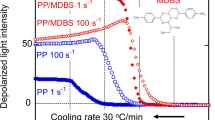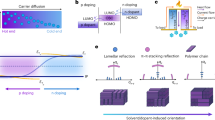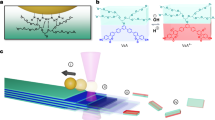Abstract
Injection-molded isotactic polypropylene (PP) containing a small amount of the β-nucleating agent N,N′-dicyclohexyl-2,6-naphthalenedicarboxamide exhibits a unique molecular orientation that is similar to that of plywood. X-ray diffraction and birefringence distribution measurements revealed that PP chains in β-form crystals are oriented perpendicular to the flow direction through epitaxial crystallization on the needle-shaped nucleating agent, even in the skin layer. Furthermore, PP chains in α-form crystals orient along the flow direction through flow-induced crystallization. Although the skin has a ‘woven-cloth’ structure in which the two crystalline forms are oriented perpendicular to each other, it shows positive birefringence, on average, because of the stronger orientation of α-form crystals. In the core, not only β-form crystals but also α-form crystals are oriented perpendicular to the flow direction. As the average orientation direction in the skin layer is perpendicular to that in the core, the dynamic tensile modulus in the flow direction is almost identical to that in the transversal direction, resulting in a low level of mechanical anisotropy. Moreover, the anisotropy in thermal expansion is greatly reduced by the extraordinary molecular orientation.
Similar content being viewed by others
Log in or create a free account to read this content
Gain free access to this article, as well as selected content from this journal and more on nature.com
or
References
Sprague, B. J. Relationship of structure and morphology to properties of “hard” elastic fibers and films. J. Macromol. Sci. Phys. B8, 157–187 (1973).
Lagasse, R. R. & Maxwell, B. An experimental study of the kinetics of polymer crystallization during shear flow. Polym. Eng. Sci. 16, 189–199 (1976).
Tan, V. & Gogos, C. G. Flow-induced crystallization of linear polyethylene above its normal melting point. Polym. Eng. Sci. 16, 512–525 (1976).
Fujiyama, M. Higher Order Structure of Injection-Molded Polypropylene. In: Karger K. (ed) Chapman & Hall, London pp 167–204 (1997).
Yamaguchi, M., Suzuki, K. & Miyata, H. Structure and mechanical properties for binary blends of i-PP with ethylene-1-hexene copolymers. J. Polym. Sci. Polym. Phys. 37, 701–713 (1999).
Coppola, S., Balzanoa, L., Gioffredi, E., Maffettone, P. L. & Grizzuti, N. Effects of the degree of undercooling on flow-induced crystallization in polymer melts. Polymer. (Guildf). 45, 3249–3256 (2004).
Kotek, J., Kelnar, I., Baldrian, J. & Raab, M. Tensile behaviour of isotactic polypropylene modified by specific nucleation and active fillers. Eur. Polym. J. 40, 679–684 (2004).
Schrauwen, B. A. G., Breemen, L. C. A. V., Spoelstra, A. B., Govaert, L. E., Peters, G. W. M. & Meijer, H. E. H. Structure, deformation, and failure of flow-oriented semicrystalline polymers. Macromolecules 37, 8618–8633 (2004).
Tadmor, Z. & Gogos, C. G. Principles of Polymer Processing, (Wiley-Interscience, New York, 2006).
Tenma, M. & Yamaguchi, M. Structure and properties of injection-molded polypropylene with sorbitol-based clarifier. Polym. Eng. Sci. 47, 1441–1446 (2007).
Zhong, G. J., Li, Z. M., Li, L. B. & Mendes, E. Crystalline morphology of isotactic polypropylene (iPP) in injection molded poly(ethylene terephthalate) (PET)/iPP microfibrillar blends. Polymer. (Guildf). 48, 1729–1740 (2007).
Nitta, K. & Yamaguchi, M. Morphology and Mechanical Properties in Blends of Polypropylene and Polyolefin-Based Copolymers In: Nwabunma D., Kyu T. (eds) Wiley-Interscience, New Jersey pp 224–268 (2008).
Geng, Y., Wang, G., Cong, Y., Bai, L., Li, L. & Yang, C. Shear-induced nucleation and growth of long helices in supercooled isotactic polypropylene. Macromolecules 42, 4751–4757 (2009).
Wang, Y., Meng, K., Hong, S., Xie, X., Zhang, C. & Han, C. C. Shear-induced crystallization in a blend of isotactic polypropylene and high density polyethylene. Polymer. (Guildf). 50, 636–644 (2009).
Yu, X., Wu, H., Li, J., Guo, S. & Qiu, J. Structure and property of injection-molded polypropylene along the flow direction. Polym. Eng. Sci. 49, 703–712 (2009).
Somani, R. H., Yang, L., Zhu, L. & Hsiao, B. S. Flow-induced shish-kebab precursor structures in entangled polymer melts. Polymer. (Guildf). 46, 8587–8623 (2005).
Zhu, P. W., Tung, J., Phillips, A. & Edward, G. Morphological development of oriented isotactic polypropylene in the presence of a nucleating agent. Macromolecules 39, 1821–1831 (2006).
Favaro, M. M., Branciforti, M. C. & Bretas, R. E. S. A x-ray study of β-phase and molecular orientation in nucleated and non-nucleated injection molded polypropylene resins. Mater. Res. 12, 455–464 (2009).
Martin, J., Margueron, S., Fontana, M., Cochez, M. & Bourson, P. Study of the molecular orientation heterogeneity in polypropylene injection-molded parts by Raman spectroscopy. Polym. Eng. Sci. 50, 138–143 (2010).
Phillips, A. W., Bhatia, A., Zhu, P. & Edward, G. Shish formation and relaxation in sheared isotactic polypropylene containing nucleating particles. Macromolecules 44, 3517–3528 (2011).
Jansen, K. M. B. Measurement and prediction of anisotropy in injection moulded PP products. Intern. Polym. Processing 13, 309–317 (1998).
Jansen, K. M. B., Dijk, D. J. V. & Frefuksen, M. J. A. Shrinkage anisotropy in fiber reinforced injection molded products. Polym. Comp 19, 325–334 (1998).
Rendona, S., Burghardta, W. R., Bubeckb, R. A., Thomasb, L. S. & Hartc, B. Mechanical and morphological anisotropy in injection molding of thermotropic liquid crystalline copolyesters. Polymer. (Guildf). 46, 10202–10213 (2005).
Zhong, G. J., Li, L., Mendes, E., Byelov, D., Fu, Q. & Li, Z. M. Suppression of skin-core structure in injection-molded polymer parts by in situ incorporation of a microfibrillar network. Macromolecules 39, 6771–6775 (2006).
Postawa, P. & Gnatowski, A. Anisotropy of physical properties injection moulded parts and its analysis. J. Achievements Mater. Manufacturing Eng. 23, 35–38 (2007).
Yi, X., Chen, C., Zhong, G. J., Xu, L., Tang, J. H., Ji, X., Hsiao, B. S. & Li, Z. M. Suppressing the skin–core structure of injection-molded isotactic polypropylene via combination of an in situ microfibrillar network and an interfacial compatibilizer. J. Phys. Chem. B. 115, 7497–7504 (2011).
Yamaguchi, M., Irie, Y., Phulkerd, P., Hagihara, H., Hirayama, S. & Sasaki, S. Plywood-like structure of injection-moulded polypropylene. Polymer. (Guildf). 51, 5983–5859 (2010).
Yamaguchi, M., Fukui, T., Okamoto, K., Sasaki, S., Uchiyama, Y. & Ueoka, C. Anomalous molecular orientation of isotactic polypropylene sheet containing N,N′-dicyclohexyl-2,6-naphthalenedicarboxamide. Polymer. (Guildf). 50, 1497–1504 (2009).
Uchiyama, Y., Iwasaki, S., Ueoka, C., Fukui, T. & Yamaguchi, M. Molecular orientation and mechanical anisotropy of polypropylene sheet containing N,N′-dicyclohexyl-2,6-naphthalenedicarboxamide. J. Polym. Sci. Polym. Phys. 47, 424–433 (2009).
Phulkerd, P., Nobukawa, S., Uchiyama, Y. & Yamaguchi, M. Anomalous mechanical anisotropy of β form polypropylene sheet with N,N′-dicyclohexyl-2,6-naphthalene- dicarboxamide. Polymer. (Guildf). 52, 4867–4872 (2011).
Yamaguchi, M. Material Design of High Performance Polypropylene Containing Nucleating Agent In: Lechkov M., Prandzheva S. (eds) Nova Science Publishers, New York pp 1043–1058 (2010).
Phulkerd, P., Hagihara, H., Nobukawa, S., Uchiyama, Y. & Yamaguchi, M. Plastic deformation behavior of polypropylene sheet with transversal orientation. J. Polym. Sci., Polym. Phys. 51, 897–906 (2013).
Li, J. X., Cheung, W. L. & Jia, D. A. A study on the heat of fusion of β-polypropylene. Polymer. (Guildf). 40, 1219–1222 (1999).
Varga, J. A beta-nukleált izotaktikus polipropilén feldolgozása I. Az izotaktikus polipropilén beta-módosulatának jellegzetességei. Műanyag és Gumi. 35, 15–19 (1998).
Housmans, J. W., Gahleitner, M., Peters, G. W. M. & Meijer, H. E. H. Structure-property relations in molded, nucleated isotactic polypropylene. Polymer. (Guildf). 50, 2304–2319 (2009).
Lotz, B. α and β phases of isotactic polypropylene: a case of growth kinetics ‘phase reentrency’ in polymer crystallization. Polymer. (Guildf). 39, 4561–4567 (1998).
Takayanagi, M., Imada, K. & Kajiyama, T. Mechanical properties and fine structure of drawn polymers. J. Polym. Sci. C. 15, 263–281 (1966).
Barham, P. J Structure and Morphology of Oriented Polymer In: Ward I. M. (eds) Chapman & Hall, London pp 142–180 (1975).
Fujiyama, M., Wakino, T. & Kawasaki, Y. Structure of skin layer in injection-molded polypropylene. J. Appl. Polym. Sci. 35, 29–49 (1988).
Huy, T. A., Adhikari, R., Lupke, T., Henning, S. & Michler, G. H. Molecular deformation mechanisms of isotactic polypropylene in α- and β-crystal forms by FTIR spectroscopy. J. Polym. Sci., Polym. Phys. 42, 4478–4488 (2004).
Tenma, M., Mieda, N., Takamatsu, S. & Yamaguchi, M. Structure and properties for transparent polypropylene containing sorbitol-based clarifier. J. Polym. Sci., Polym. Phys. 46, 41–47 (2008).
Yu, F., Zhang, Z., Yu, W., Zhou, C. & Zhang, H. Modeling of flow-induced crystallization in blends of isotactic polypropylene and poly(ethylene-co-octene). Polym. Int. 61, 1389–1393 (2012).
Perkins, W. G. Polymer toughness and impact resistance. Polym. Eng. Sci. 39, 2445–2460 (1999).
Cermak, R., Obadal, M., Ponizil, P., Polaskova, M., Stoklasa, K. & Heckova, J. Injection-moulded α- and β-polypropylenes: II. Tensile properties vs processing parameters. Eur. Polym. J. 42, 2186–2191 (2006).
Lezak, E. & Bartczak, Z. Plastic deformation behavior of β phase isotactic polypropylene in plane-strain compression at elevated temperatures. J. Polym. Sci., Polym. Phys 46, 92–108 (2008).
Luo, F., Geng, C., Wang, K., Deng, H., Chen, F. & Fu, Q. New understanding in tuning toughness of β-polypropylene: the role of β-nucleated crystalline morphology. Macromolecules 42, 9325–9331 (2009).
Labour, T., Gauthier, C., Seguela, R., Vigier, G., Bomal, Y. & Orange, G. Influence of the β crystalline phase on the mechanical properties of unfilled and CaCO3-filled polypropylene. Polymer. (Guildf). 42, 7127–7135 (2001).
Jansen, B. J. P., Rastogi, S., Meijer, H. E. H. & Lemstra, P. J. Rubber-modified glassy amorphous polymers prepared via chemically induced phase separation. 3. Influence of the strain rate on the microscopic deformation mechanism. Macromolecules 32, 6283–6289 (1999).
Jacobsen, A. J., Barvosa-Carter, W. & Nutt, S. Shear behavior of polymer micro-scale truss structures formed from self-propagating polymer waveguides. Acta. Mater. 56, 1209–1218 (2008).
Hall, C. Polymer Materials, John Wiley & Sons, New York, (1981).
Author information
Authors and Affiliations
Corresponding author
Rights and permissions
About this article
Cite this article
Phulkerd, P., Hirayama, S., Nobukawa, S. et al. Structure and mechanical anisotropy of injection-molded polypropylene with a plywood structure. Polym J 46, 226–233 (2014). https://doi.org/10.1038/pj.2013.88
Received:
Revised:
Accepted:
Published:
Issue date:
DOI: https://doi.org/10.1038/pj.2013.88
Keywords
This article is cited by
-
The effect of masterbatch pigments on the crystallisation, morphology, and shrinkage behaviour of Isotactic Polypropylene
Journal of Polymer Research (2022)
-
Effect of water and carbonyl sulfide toxins in gas propylene feed in polymerization process on physical properties of polypropylene
Journal of Polymer Research (2019)
-
Improvement of mechanical toughness of polypropylene by laminating with elastomer
Journal of Polymer Research (2019)
-
Perpendicular orientation between dispersed rubber and polypropylene molecules in an oriented sheet
Polymer Journal (2018)
-
Uncovering three-dimensional gradients in fibrillar orientation in an impact-resistant biological armour
Scientific Reports (2016)



